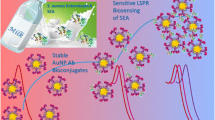Abstract
A previously developed fluorescence sensing platform, combining spatial illumination using electroluminescence (EL) semiconductor strips with charge coupled device (CCD)-based detection (EL-CCD), was adapted to a new 96-well chip for colorimetric immunological assays, enhancing the capabilities of the EL-CCD platform. The modified system was demonstrated using a colorimetric-based enzyme linked immunosorbent assay (ELISA) for detection of staphylococcal enterotoxin B (SEB). Limits of detection (LODs) of 3.9 ng/mL (±2.4 ng/mL) SEB were determined with the ELISA chip measured using the EL-CCD platform, following a standard 4-h ELISA protocol. The LODs were comparable to those obtained using standard 96-well ELISA plates measured using a standard laboratory 96-well plate reader. The miniature 96-well ELISA chip however required as little as 5-µL samples, representing a tenfold reduction in sample volume compared to a standard 96-well ELISA plates. The ELISA chip also demonstrated detection of SEB spiked into various food matrices (milk, mushrooms, and mayonnaise) using limited-to-no sample preparation, with LODs ranging from 3.9 to 18.5 ng/mL depending on the matrix. The EL-CCD platform is versatile, capable of multi-mode detection (e.g., fluorescent and colorimetric along with solution and solid phase assays), and could readily be applied to other field portable or point-of-care applications.

Detection of SEB using miniature ELISA chips coupled with a portable electroluminiscent-charge couple device (EL-CCD) detection system.



Similar content being viewed by others
References
Balaban N, Rasooly A (2001) Int J Food Microbiol 64:33–40
Jarraud S, Mougel C, Thioulouse J, Lina G, Meugnier H, Forey F, Nesme X, Etienne J, Vandenesch F (2002) Infect Immun 70:631–641
Omoe K, Ishikawa M, Shimoda Y, Hu DL, Ueda S, Shinagawa K (2002) J Clin Microbiol 40:857–862
Sergeev N, Volokhov D, Chizhikov V, Rasooly A (2004) J Clin Microbiol 42:2134–2143
Archer DL, Young FE (1988) Clin Microbiol Rev 1:377–398
Bean NH, Goulding JS, Lao C, Angulo FJ (1996) Morb Mortal Wkly Rep CDC Surveill Summ 45:1–66
Bunikowski R, Mielke M, Skarabis H, Herz U, Bergmann RL, Wahn U, Renz H (1999) J Allergy Clin Immunol 103:119–124
Garthright WE, Archer DL, Kvenberg JE (1988) Public Health Rep 103:107–115
Olsen SJ, MacKinnon LC, Goulding JS, Bean NH, Slutsker L (2000) Morb Mortal Wkly Rep CDC Surveill Summ 49:1–62
Howell MD, Diveley JP, Lundeen KA, Esty A, Winters ST, Carlo DJ, Brostoff SW (1991) Proc Natl Acad Sci U S A 88:10921–10925
Uematsu Y, Wege H, Straus A, Ott M, Bannwarth W, Lanchbury J, Panayi G, Steinmetz M (1991) Proc Natl Acad Sci U S A 88:8534–8538
Breuer K, Wittmann M, Bosche B, Kapp A, Werfel T (2000) Allergy 55:551–555
Mempel M, Lina G, Hojka M, Schnopp C, Seidl HP, Schafer T, Ring J, Vandenesch F, Abeck D (2003) Eur J Clin Microbiol Infect Dis 22:306–309
Herz U, Bunikowski R, Mielke M, Renz H (1999) Int Arch Allergy Immunol 118:240–241
Henghold WB (2004) Dermatol Clin 22:257–262
Ler SG, Lee FK, Gopalakrishnakone P (2006) J Chromatogr 1133:1–12
Rosenbloom M, Leikin JB, Vogel SN, Chaudry ZA (2002) Am J Ther 9:5–14
Su Y-C, Lee Wong AC (1997) J Food Prot 60:195–202
Poli MA, Rivera VR, Neal D (2002) Toxicon 40:1723–1726
Bennett RW (2005) J Food Prot 68:1264–1270
Shriver-Lake LC, Shubin YS, Ligler FS (2003) J Food Prot 66:1851–1856
Sapsford KE, Taitt CR, Loo N, Ligler FS (2005) Appl Environ Microbiol 71:5590–5592
Medina MB (2006) J Agr Food Chem 54:4937–4942
Khreich N, Lamourette P, Boutal H, Devilliers K, Créminon C, Volland H (2008) Anal Biochem 377:182–188
Kijek TM, Rossi CA, Moss D, Parker RW, Henchal EA (2000) J Immunol Methods 236:9–17
Yacoub-George E, Hell W, Meixner L, Wenninger F, Bock K, Lindner P, Wolf H, Kloth T, Feller KA (2007) Biosens Bioelectron 22:1368–1375
Yang M, Kostov Y, Bruck HA, Rasooly A (2008) Anal Chem 80:8532–8537
Chatrathi MP, Wang J, Collins GE (2007) Biosens Bioelectron 22:2932–2938
Medina MB (2005) J Rapid Methods Autom Microbiol 13:37–55
Maraldo D, Matharasan R (2007) Anal Chem 79:7636–7643
Mulvaney SP, Myers KM, Sheehan PE, Whitman LJ (2009) Biosens Bioelectron 24:1109–1115
Branen JR, Hass MJ, Douthit ER, Maki WC, Branen AL (2007) J Food Prot 70:841–850
Callahan JH, Shefcheck KJ, Williams TL, Musser SM (2006) Anal Chem 78:1789–1800
Sapsford KE, Sun S, Francis J, Sharma S, Kostov Y, Rasooly A (2008) Biosens Bioelectron 24:618–625
Sapsford KE, Farrell D, Sun S, Rasooly A, Mattoussi H, Medintz IL (2008) Sens Actuator B: Chemistry, ASAP. doi:10.1016/j.snb.2008.07.026
Acknowledgments
This work was supported in part by the Office of Public Health emergency Preparedness (OPHEP) IAG 224-05-655 (to A. Rasooly and by FDA contract) and HHSF223200610765P (to Dr. Yordan Kostov) and CDRH/OSEL/Division of Biology funds. The mention of commercial products, their sources, or their use in connection with material reported herein is not to be construed as either an actual or implied endorsement of such products by the Department of Health and Human Services
Author information
Authors and Affiliations
Corresponding author
Electronic supplementary material
Below is the link to the electronic supplementary material.
ESM 1
(PDF 57kb)
Rights and permissions
About this article
Cite this article
Sapsford, K.E., Francis, J., Sun, S. et al. Miniaturized 96-well ELISA chips for staphylococcal enterotoxin B detection using portable colorimetric detector. Anal Bioanal Chem 394, 499–505 (2009). https://doi.org/10.1007/s00216-009-2730-z
Received:
Revised:
Accepted:
Published:
Issue Date:
DOI: https://doi.org/10.1007/s00216-009-2730-z




